This recipe makes a small batch of delicious buttery puff pastry that can be used for making sweet or savoury pies, fruit tarts, canapés, vol au vents, sausage rolls and much more.
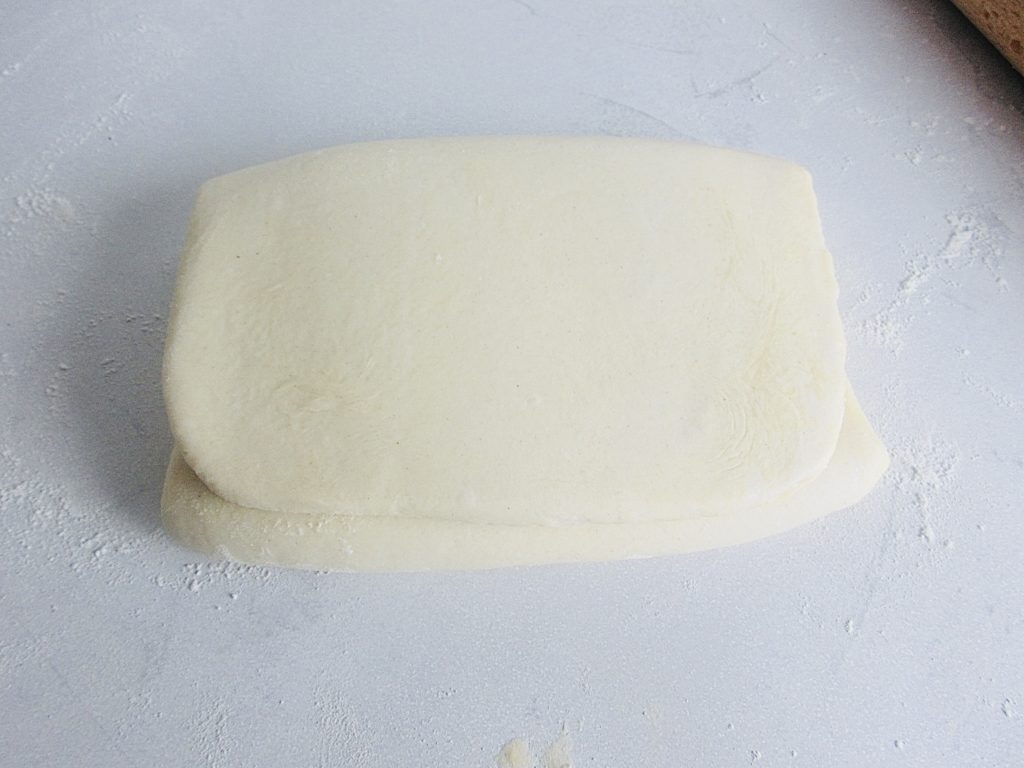
It took me a while to master puff pastry but I now have a recipe that I am very proud of and comes out perfect every time I use it. Making puff pastry is definitely not for the faint hearted but if you’re able to master it, you'll feel a sense of achievement.
Now, I am going be very honest and say that this recipe is time consuming and it not the easiest recipe to make but if you read the notes and read through the recipe before starting, it will be much easier for you.
This recipe is for a small batch of puff pastry because sometimes you don’t need too much but a good thing about this recipe is that you can make larger batches by doubling the recipe.
This puff pastry is flaky and tender with a delicious buttery flavour and all the work that goes into it is well worth it. There are many different puff pastry recipes that you can follow and many cheat puff pastries and honestly these are all amazing but I chose to make my puff pastry using one of the French methods.
This method is done by making a dough which is known as the détrempe then separately making a butter block called the beurrage that is placed and sealed within the détrempe. The dough is rolled out with the butter inside then folded and refrigerated. The process of rolling, folding and refrigerating is repeated until you have those beautiful buttered layers that will puff up when baked.
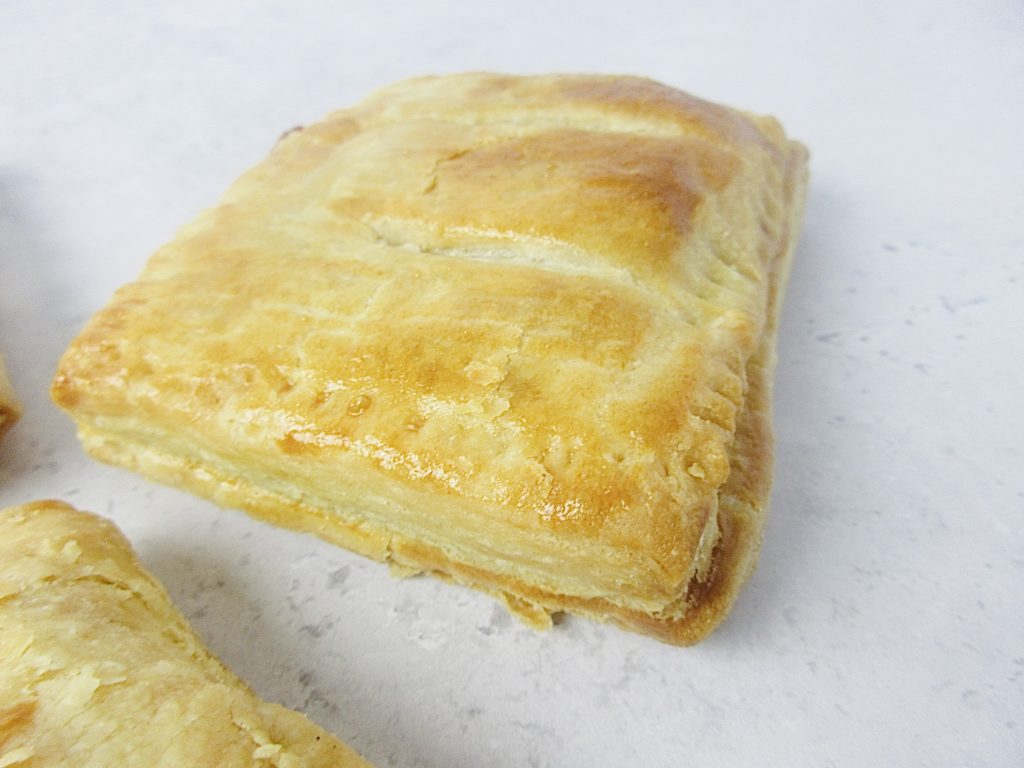
The Science Behind Puff Pastry!
So, you’ve sealed in butter and rolled it out with the dough. You’ve folded the dough a few times and then you will bake the puff pastry. When you place the dough in the oven, the water from the dough and the butter will create steam. The steam will puff up the pastry between the layers of butter before evaporating in the oven. You’re then left with a gorgeous flaky pastry.
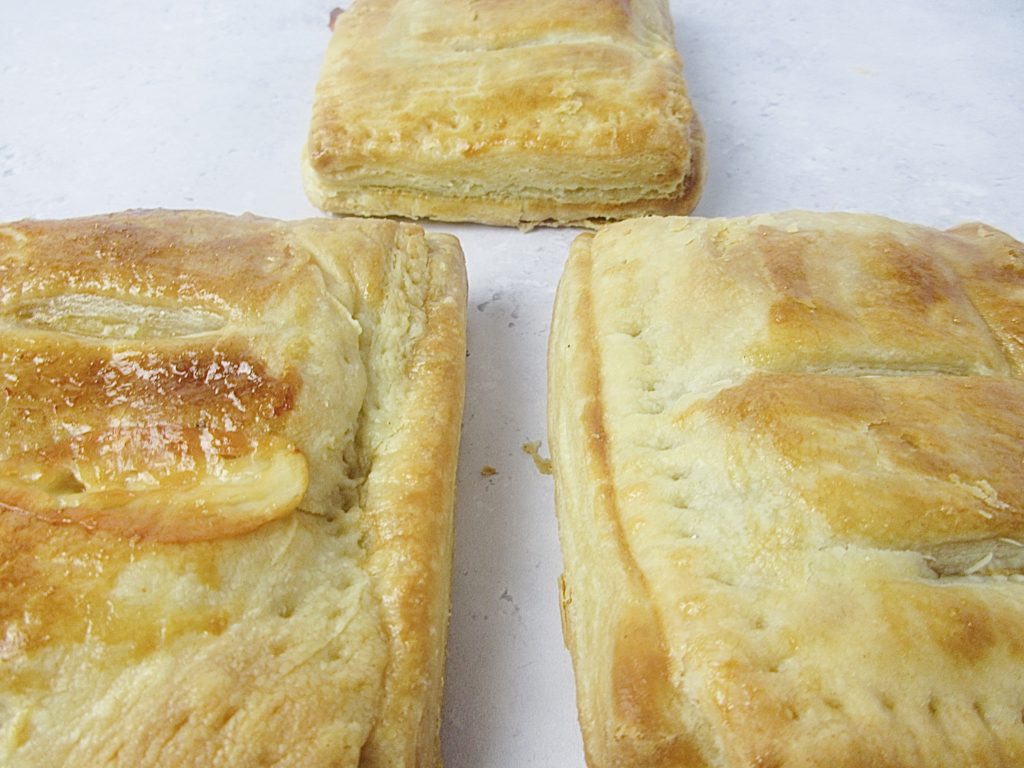
Ingredients for Puff Pastry
Please find the full list of ingredients and quantities in the recipe card at the end of the post.
For the Main Dough (détrempe)
- Flour - I use a combination of strong bread flour and plain flour.
- Sugar - I use caster sugar to sweetened the dough but you can leave out the sugar if you wish.
- Salt - use fine sea salt.
- Lemon juice - use juice from a fresh lemon to tenderise the pastry.
- Butter - I use unsalted butter for the main dough which should be very soft.
For the Butter Block (beurrage)
- Butter - use unsalted butter for the butter block which should be slightly soft.
- Flour - add a little bread flour to the butter block will give it some structure and make it easier to roll.
How to Make Puff Pastry
Make the détrempe
1. To a stand mixer bowl add both the flours, sugar, salt, lemon juice and water. Using a dough hook on a medium setting mix the ingredients together. While the ingredients are mixing add in the soft butter and continue to mix until a dough has formed. Remove the dough from the bowl and shape into a square. Wrap in cling film and place in the fridge while you make the butter block.

Make the beurrage
2. To the same bowl you used to make the main dough, add the flour and the soft butter. Remove the dough hook and attach the paddle then beat the butter and flour until well combined. Pour out the butter and flour onto a piece of parchment paper and shape into a square block as pictured. The block should be approximately 14cm in length, 11cm in width and have a depth of around 1.5 cm. Wrap the shaped block in the parchment paper and refrigerate until it is the same consistency as the main dough. This could take between 30 and 90 minutes.

Place the beurrage Inside the détrempe
3. Remove the dough and butter block from the fridge. Lightly dust a work surface then roll out the dough to double the size of the butter and place the butter block on half of the rolled-out pastry. Try and leave a little gap at the edge. Fold the pastry over the butter block then seal the edges by pushing around the edges with your finger. Fold any excess pastry underneath the butter block until you have a square securely around the butter block.
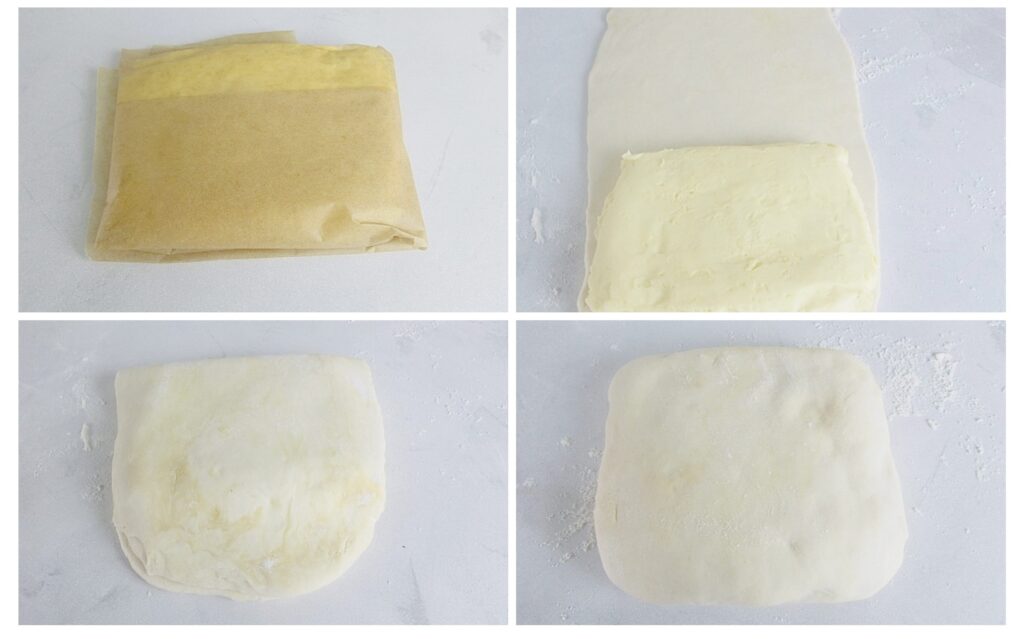
Give the dough the first fold
4. Roll the dough out longways to around 25cm length and 16cm width then fold over a quarter of the pastry then fold the remaining pastry on top. Turn the dough 90 degrees and roll it out again then repeat the folding. Place the dough back in the fridge for around 2 hours then repeat the roll out and fold process around 3 – 4 more times, refrigerating for 2 hours between each set of folds.
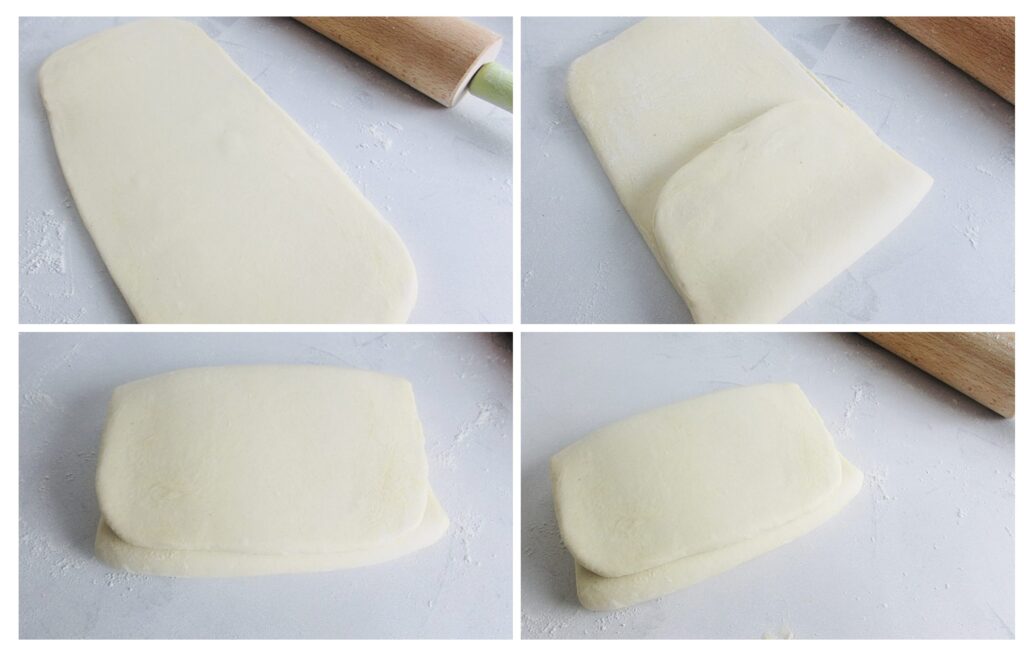
5. After the last fold, refrigerate the dough for around 2 hours before rolling out and using for your puff pastry recipe.
Recipe Tips
- When you plan to make puff pastry for a particular recipe, it’s best to make the puff pastry a day before as it will need rest time before using.
- For this recipe I use a mix of bread flour and plain. Bread flour provide an elastic texture due to the high protein content and helps the pastry to stretch without tearing.
- This recipe is best prepared using a stand mixer with a dough hook and paddle. You can do this by hand but I wouldn’t advise it.
- When rolling out the dough to make your recipe, ensure you don't roll it out too thin as you will destroy your layers and it won't puff up. If you roll it out and can no longer see your layers then you have rolled it out too thin and will end up with shortcrust pastry onced baked.
- If you want a larger batch of puff pastry, you can easily double this recipe.
- I usually do a test bake to check the layers of my puff pastry. If you decided to also do this, then cut and roll out a small piece of the pastry to around 3 – 4 mm in thickness and bake in an oven preheated to gas mark 6/400oF/200oC for 15 - 20 minutes.
Troubleshooting
When making puff pastry, you can sometimes encounter a few problems. Below are some of the problems that I’ve come across and how I solved them. Remember most problems can be fixed when making puff pastry so just take your time. Don’t rush anything and if something goes wrong, don’t panic. Most problems will usually occur at the beginning of the recipe.
- When folding the pastry, ensure you dust off any excess flour with a pastry brush. This prevents your pastry layers from separating.
- If you get any air pockets in your dough, just use a sharp object to pierce it then smooth it by rolling over the area with the rolling pin.
- If you find any exposed butter when rolling out the pastry to fold, just sprinkle some flour on the exposed area then smooth over the area with the rolling pin.
- The process of making this puff pastry will require you to roll out the dough multiple times between refrigeration. When you remove the dough from the fridge, ensure it is not too firm before you roll it out. If the dough is too firm then allow to rest at room temperature for a few minutes to slightly soften. You want the dough to be firm but pliable. If the dough is too firm, it may start to crack when rolling it out.
- If at any point your pastry starts to become too soft when rolling it out, return it to the fridge immediately until it becomes firmer. You don’t want your butter to melt and ruin your layers.
Storage
This puff pastry can be stored in the fridge for a few days and can be stored in the freezer for up to 3 months. Remove from the freezer and allow to thaw in the fridge for 12 hours before use. Once thawed do not refreeze.
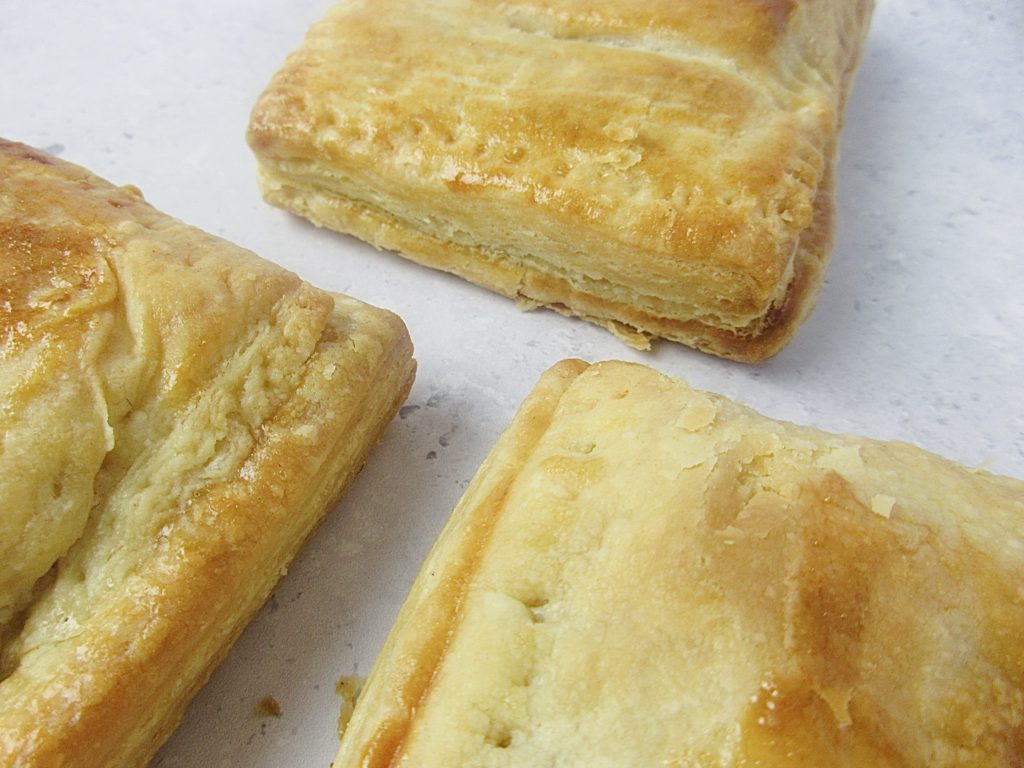
Recipes You May Like!
- Chicken Chorizo and Chilli Pizza
- Creamy Tomato Sausage Pasta Bake
- Left Over Roast Chicken and Sweetcorn Mini Quesadillas
Puff Pastry Recipe (All Butter)
Ingredients
Main Dough
- 170g strong bread flour
- 90g plain flour
- 1 teaspoon caster sugar (optional)
- 1 teaspoon salt
- 2 teaspoon lemon juice
- 125ml water
- 50g unsalted butter (soft)
Butter Block
- 200g unsalted butter (soft)
- 40g strong bread flour
Instructions
- Make the détrempe: To a stand mixer bowl add both the flours, sugar, salt, lemon juice and water. Using a dough hook on a medium setting mix the ingredients together. While the ingredients are mixing add in the soft butter and continue to mix until a dough has formed. Remove the dough from the bowl and shape into a square. Wrap in cling film and place in the fridge while you make the butter block.
- Make the beurrage: To the same bowl you used to make the main dough, add the flour and the soft butter. Remove the dough hook and attach the paddle then beat the butter and flour until well combined. Pour out the butter and flour onto a piece of parchment paper and shape into a square block as pictured. The block should be approximately 14cm in length, 11cm in width and have a depth of around 1.5 cm. Wrap the shaped block in the parchment paper and refrigerate until it is the same consistency as the main dough. This could take between 30 and 90 minutes.
- Place the beurrage inside the détrempe: Remove the dough and butter block from the fridge. Lightly dust a work surface then roll out the dough to double the size of the butter and place the butter block on half of the rolled-out pastry. Try and leave a little gap at the edge. Fold the pastry over the butter block then seal the edges by pushing around the edges with your finger. Fold any excess pastry underneath the butter block until you have a square securely around the butter block.
- Give the dough the first fold: Roll the dough out longways to around 25cm length and 16cm width then fold over a quarter of the pastry then fold the remaining pastry on top. Turn the dough 90 degrees and roll it out again then repeat the folding. Place the dough back in the fridge for around 2 hours then repeat the roll out and fold process around 3 – 4 more times, refrigerating for 2 hours between each set of folds.
- After the last fold, refrigerate the dough for around 2 hours before rolling out and using for your puff pastry recipe.

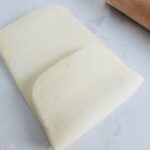
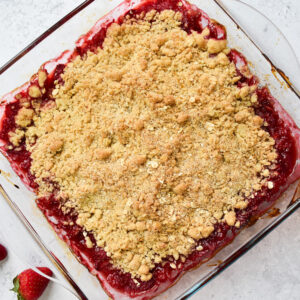
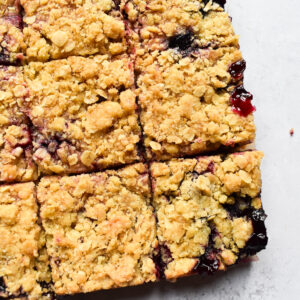
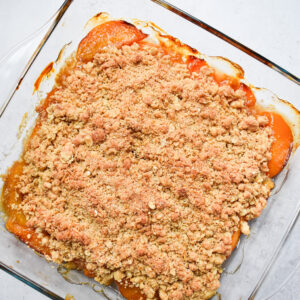
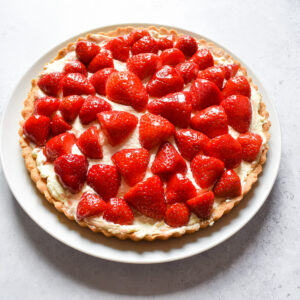
Amanda says
Thank you for sharing. This is the best way to make puff pastry in my experience. Just a quick question. Do you know how this recipe turns out if you use margarine?
Andrea says
Hi Amanda, thank you for your comment. I am not sure how this recipe will turn out with margarine as I haven't tried it. Sorry I couldn't be more helpful. If you do happen to give it a try, I'd appreciate you letting me know how it turns out.